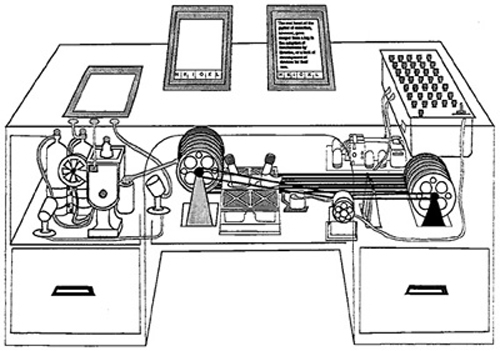By Christopher Field, MFA ’11
essay
Throughout the lurid and sundry course of human technological history, mankind has continuously and relentlessly sought ways of improving the human condition. Whether it be figuring out how to fashion a round stone to construct a wheelbarrow to make the carrying of, well, things easier or unlocking the power of the atom to achieve cataclysmic energy sources because we can, the human race does not rest. It hurtles forward at a breakneck pace with little regard for anything but progress, launching rockets at the moon, searching for the next new thing, for transcendence, for efficiency, for transcendence through efficiency, trying to make it easier (and sometimes harder) to be alive on this planet and exist, conscientious objectors, Luddites, and Betamax™ enthusiasts be damned. Does our technology make our lives better or simply more efficient? Does the digitalization of media and the abstraction of the physical realm make it easier to exist as a person in the 21st century?
Many authors, scientists, cultural critics and computer geek-type people have written extensively about this ongoing quest of salvation through technology. In his 1945 essay As We May Think, Vannevar Bush, fresh from coordinating The Manhattan Project and apparently ready to turn his attention to something not lighter, but perhaps less heavy , writes, of man, that
He has built a civilization so complex
that he needs to mechanize his records
more fully if he is to push his experiment
to its logical conclusion and not merely
become bogged down part way there by
overtaxing his limited memory.
Bush proposes a user-friendly system that will document and present knowledge in a way that will make the information more accessible and instinctual to the user. He gives this device the shape of a desk and the vaguely futurist moniker “the memex”. By cataloguing data “by association, rather than indexing”, people would be able to access information as they think, with data being available concurrently with their thoughts. For example, in the midst of, say, an intense thinking session, when the user/thinker comes upon a thought or subject worth researching, rather than having to pause to look up the topic in the traditional alphabetical or categorical sense, the user would have a sort of thinking buddy alongside him or her—the memex—feeding the user data and associations. Thus, the intense thinking session could continue in an uninterrupted and, theoretically, enhanced way. The device would also allow the user to record these sessions, with the idea being that these associative trails would become knowledge in and of themselves, to be subsequently indexed and associated by other tech-savvy intense thinkers. The process of thinking becomes knowledge.
Obviously, the memex as described by Bush does not yet exist. However, the desktop computer could conceivably function in the same way; certainly the processing power and quantities of data storage that Bush called for can be achieved; today a hard drive with a terabyte storage capacity can be purchased for $98.95. However, the computer remains more of a data holder/retrieval device than a sort of thinking companion. Perhaps the way we associate things has yet to be understood in a way programmable for a computer to emulate, or more importantly, associate on its own. Elkhonen Goldberg, in his book The Executive Brain: Frontal Lobes and the Civilized Mind, asks whether “human beings recapitulate, consciously or unconsciously, their own internal organization in man-made devices.” Computer programming is taxonomic and hierarchal because it follows the way we, as people, order and classify things; to diverge from this way of cataloguing would be to, in a sense, diverge from our biology. However, the ability to abstract and associate forms the space between the branches, so to speak, one that we have yet to fill in the computer/database model. So, basically, the memex would likely be totally awesome, but we haven’t figured out a way to make its specific kind of awesomeness tangible.
In his 1962 report, Augmenting Human Intellect, Douglas Engelbart describes the conceptual framework and usability behind what would later be developed into the word processor. In a McInerney-esque second person narrative, he opines on the user’s reaction to such a device, basically the ability to easily edit and maneuver large sections of text:
You are elated by this freedom to juggle
the record of your thoughts, and by the
way this freedom allows you to work them
into shape. You reflected that this flexible
cut-and-try process really did appear to
match the way you seemed to develop your thoughts.
The word processor is undoubtedly a more efficient tool of the physical act of writing. Even a novice, two-finger-at-a-time typist can produce text at a far faster rate than by writing by hand. And the ability to copy, cut and paste text renders the editing/revision of a document as an almost instantaneous action. However, by abstracting the inputted text into a database to be sorted and arranged by the word processor or word processing program, the writer loses a direct physical connection to the work. Consider the novelist Don DeLillo, who continues to use a manual typewriter some thirty years on from the commercial introduction of the word processor. In a 1993 interview, he describes his reason for eschewing the “cut-and-try” wonderland of Engelbert’s former imagination:
I don’t use a word processor because I
like the feeling of touching the paper,
of making changes with a pencil or pen,
of saving old pages that one can return
to in a year or so. I save every note
and this, too, is part of the tactile
dimension of writing.
Granted, novelists are notoriously habit-intense people who can be change-resistant and who work in a medium that some consider to be dying. However, DeLillo raises an interesting point. Though writing includes the organization of text, it is not the only dimension of the process. At some point the ideas that form the content of the text need to be generated, and the ability to maneuver the text does not specifically engender the creativity of ideas. Most writing is not judged by how quickly it is done or by how much of it is there is; it is judged by the content that it contains. The tool of the word processor helps one write more efficiently in a raw-data input sense, but not necessarily better in a content-focused perspective . It ignores the idea of writing as a tactile experience in favor of data input proficiency.
In The Language of New Media, Lev Manovich states “creating works in new media can be understood as either constructing the right interface to a multimedia database or as defining navigation methods through specialized representations.” Using this definition, a GPS navigation device can be seen as a new media object. A GPS is essentially an interface, whether it is a touch screen display or a voice-activated response system, to a multimedia database, which in this case is a series of maps, coordinates, data points and information. The device is marketed and sold as a tool for people to use to help them find their way, usually while driving. Using a satellite as a beacon to achieve a relative location on a global data grid, the user can plot routes or trips, look up specific destinations, and instantaneously receive directions to those destinations. The arguable intent of the device is to give the viewer a better understanding and knowledge of geography, or at the very least, give the user the fastest route from point A to point B.
When used incorrectly or too dependently, however, the device can function as a sort of confused helper dog, leading the suddenly and somewhat needlessly blind user by an algorithmically-programmed leash. Stories of people using their GPS to traverse back-of-the-hand-type routes for possible glimpses of unknown efficiency only to end up on an unnecessary toll road, or the wrong way on a one way, or worse abound in the public lexicon. Normally navigation-savvy city dwellers can be turned into confused bumpkins when the interface or the database or both fail. However, this hazard occurs when the object is used improperly. As a new media object, the system is constantly being updated and troubleshot; new data is entered and stored in the database as it becomes more accurate and hopefully more useful.
Does the GPS device improve the human condition? When working as a Production Assistant on an independent film project shortly after moving to Los Angeles, I was sent on a run to pick up a piece of lighting equipment. One of the grips programmed the address of the rental house into the device and gave it to me for the trip. At the time, I had very little road/geographic knowledge of the city and had I not had the device, I might still be lost in the San Fernando Valley or beyond. So, after following the directions of the GPS device, I was able to pick up the equipment and return to the set without incident. However, I didn’t learn where I was going or where I had gone; I was, or acted, in a sense, blind; holding on to the leash, hoping the dog would pull me where I needed to be. This new media object but didn’t increase my knowledge base or help me think, as, say, the memex theoretically would, but it enhanced my life for a temporary period of time, and that’s something for which I was grateful.
Perhaps that is all we can ask of new media, or of anything: to make each moment more tolerable than the last. Rather than expecting earth shattering change and transcendence, we should look at ways in which we can improve ourselves and our lives on a micro-scale, moment by moment, billions of ones and zeros at a time.
Bibliography
Vannevar Bush, As We May Think (The New Media Reader, Cambridge, 2003), p. 45-47 (originally published in Atlantic Monthly, July 1945.)
Douglas Engelbert, Augmenting Human Intellect (The New Media Reader, The MIT Press, Cambridge, 2003), p. 104 (originally published in Summary Report AFOSR-3223 under Contract AF49(638)-1024, SRI Project 3578 for Air Force Office of Scientific Research, Menlo Park, California: Stanford Research Institute, October 1962.)
Lev Manovich, The Language of New Media (The MIT Press, Cambridge, 2001), p. 215
Maria Nadotti, An Interview with Don DeLillo (Salmagundi 100, Fall, 1993), p. 93
Lawrence Weschler, Everything That Rises (McSweeney’s Press, San Francisco, 2003), p. 216.
http://www.amazon.com/Iomega-Prestige-Desktop-External-34275/dp/B001D7REJ4/ref=sr_1_2?ie=UTF8&s=electronics&qid=1255541893&sr=8-2



